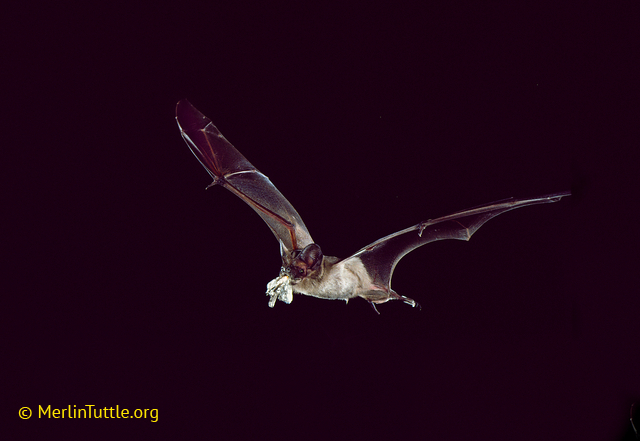
by hollyober | Oct 22, 2016
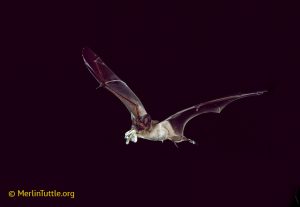
Brazilian free-tailed bat (Tadarida brasiliensis) eating a corn earworm moth (Helicoverpa zea).
If you think you’d prefer a world without bats, we present to you three reasons to reconsider. Most negative stereotypes about bats are untrue. The reality is that bats benefit us in numerous ways. Here are a few facts that may convince you we should be thankful for bats rather than fearful of them.
1. INSECTS WOULD BUG YOU MORE IF WE HAD NO BATS
Over two-thirds of the 1,240 species of bats that roam the earth’s skies feed on insects. These aerial acrobats cruise over forests, grasslands, waterways, and crop fields, assisting us by consuming nighttime insects. Bats collect insects using a variety of innovative approaches: some scoop them from the air with their wing or tail membrane and transfer them to their mouths; others nimbly pluck insects off surfaces such as leaves, tree trunks, or even water. These bats are our allies, as they drastically reduce the number of pests that would otherwise bite us or damage our crops. It’s estimated that bats help North American farms save around $23 billion a year. If all bats were lost, the resulting damage to crops due to the insects bats formerly kept in check is estimated to be $74/acre across the US.
2. SOME FOODS AND DRINKS MIGHT BECOME RARE IF WE HAD NO BATS
If you like tropical fruits like mangoes, papayas, guavas, bananas, or figs, you should be thankful for bats. Many bats in the tropics and sub-tropics pollinate and disperse seeds in ecosystems ranging from deserts to rainforests. Bats in the desert visit columnar cacti and agaves, ensuring pollination of the plants responsible for making tequila. Bats in the rainforests help regenerate new forests and ensure availability of many locally-consumed and highly-nutritious fruits.
3. BATS CAN HELP US SOLVE MEDICAL PUZZLES
Bats possess many unique biological adaptations that hold clues vital to solving human health issues. Bats have already made notable contributions to the medical community. The special blood thinning enzymes found in the saliva of vampire bats has helped us understand how to prevent blood clotting during open-heart surgery. The adaptations bats have for seeing in the dark are being studied to see if they could provide insight useful for assisting people who have limited vision.
Despite the many ways bats help us, they remain misunderstood by many. Fear of bats, called chiroptophobia, is the result of negative stereotypes about bats. Most of these stereotypes are downright untrue. First, there’s a common belief that bats get caught in people’s hair. This is highly unlikely: if a bat is agile enough to catch an insect the size of a gnat in flight, it can certainly steer clear of a human head. Second, there’s a common fear that all bats have rabies. In fact, rabies is quite rare among bats, and much more common among raccoons and foxes in Florida. Third, despite the portrayal in movies of bats as aggressive towards humans, bats are in reality not likely to bother people. In fact, they’re generally far more afraid of you than you are of them.
If you’d like to help bats (and perhaps get some free control of insect pests in your area), consider building or buying a bat house for your property. Also consider leaving dead and dying trees in your yard if they’re not a safety hazard, avoid trimming dead fronds off your palm trees, and retain Spanish moss. All of these locations (tree cavities, dead palm fronds, and Spanish moss) offer roosting habitat for bats. By promoting bat habitat, you may boost local bats and find you have fewer insect pests nearby.
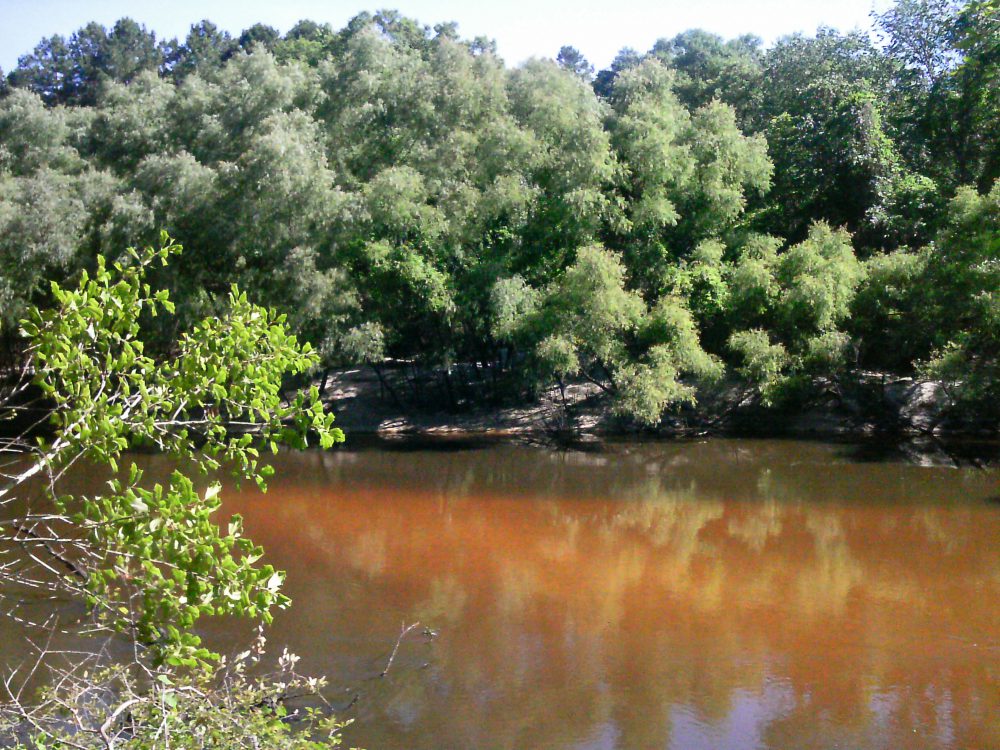
by Will Sheftall | Oct 22, 2016
What do the Ochlockonee and Aucilla rivers have in common? Not much, it would seem, beyond the fact that both have headwaters in Georgia and flow through Florida to the Gulf of Mexico. These two rivers do share the distinction of being unusual, although they’re unusual in very different ways.
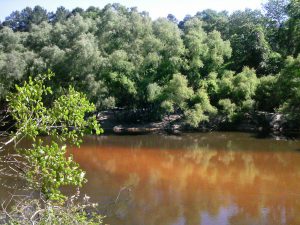
The Ochlockonee runs yellow-brown between Leon and Gadsden counties.
Photo: Rosalyn Kilcollins
The Aucilla is a blackwater stream that goes underground and rises again before reaching the Gulf – a disappearing act that has fascinated early settlers, paddlers and naturalists alike. The Aucilla drains a smaller watershed, has lower flows, and features stream channel sediments that are predominantly sands and decaying organic material – the sediment signature of coastal plain streams with water stained dark brown, the color of tea.
In fact, blackwater rivers like the Aucilla get their color by steeping fallen and decaying tree leaves and twigs in slow-moving water, just as we steep shredded tea leaves or ground up coffee beans to dissolve their tannic acids into beverages. Blackwater steeping occurs in swamp forests up river tributaries, and in oxbow sloughs and other quiescent side channels of the downstream reaches. These form as a river “in flood” meanders and changes course within its floodplain.
The Ochlockonee is unusual among rivers originating in the Coastal Plain: in its upper reaches it has alluvial characteristics common to streams flowing from the Piedmont. The Ochlockonee drains soils rich in silt and clay that give it a yellowish brown color when those extremely fine sediments are suspended in the water. Land use activities such as paving roads and tilling farm fields elevate the fine sediment load when it rains by setting up larger volumes of fast-moving runoff. Higher rain runoff volume and velocity conspire to erode bare fields, construction sites and river banks, accentuating this river’s color.
But in spite of these differences, the Aucilla and Ochlockonee were once branches of the same river drainage system – the Paleo-Ochlockonee River. How could that possibly be? Well, sea level rise has drowned the lower reaches of this once mightier river, leaving its upper branches to empty into the Gulf separately, as smaller streams.
Sea level along Florida’s Big Bend coastline has been rising since the end of Earth’s last Ice Age – roughly 18,000 years ago. Our shallow, gently sloping underwater continental shelf was exposed during that last period of glaciation. As higher temperatures began melting ice sheets, not only did sea level rise, but more water evaporated and fell as rain. Southeastern rivers began carrying greater volumes of water.
Before annual rainfall reached today’s level during this prehistoric period of climate change, it is likely that the Aucilla from headwaters to Gulf was even more discontinuous than it is today. A current hypothesis is that the Aucilla was more like a string of sinkholes than a river, resembling its lower reaches today in a section known as the “Aucilla Sinks.”
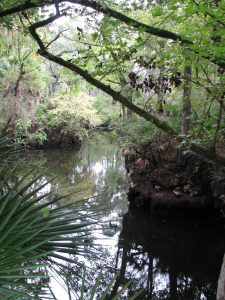
The Aucilla is a tannic river. Thus not as yellow-brown but rather more “blackwater”.
Photo: Jed Dillard
But the nature of the Paleo-Aucilla is just one part of this intriguing story. Using sophisticated technology, scientists have discovered clues about the ancient route of the entire Paleo-Ochlockonee as it meandered across that more expansive, exposed Continental shelf to the Gulf.
In their 2008 publication Aucilla River, Tall Timbers Research Station & Land Conservancy reports that, “Ten thousand years ago, the Florida coastline was located 90 miles away from its present position. Scientists have discovered a buried river drainage system indicating that approximately 15 to 20 miles offshore from today’s coast — and now underwater — the Aucilla River combined with the Ochlockonee, St. Marks, Pinhook, and Econfina rivers to create what archeologists call the Paleo-Ochlockonee, which flowed another 70 miles before reaching the Gulf.”
“Well, I’ll be!” you say, “That’s all pretty cool to think about.” That was my reaction, too, until I remembered that this process of sea level rise continues still, albeit at an accelerating rate thanks to global warming. Which means our rivers that join forces today before emptying into the Gulf will one day be separated. Sea level rise eventually will dismember the Wakulla from the St. Marks, and the Sopchoppy from the Ochlockonee – but thankfully not in our lifetime.
True, that’s happened before, but long before humans were on the scene. Today and for many tomorrows to come, I am grateful that we and our children and grandchildren have a wonderful watery world patiently awaiting our exploration, not far beyond the urban bustle of Tallahassee.
We’re far removed in time from the first humans beckoned by these rivers. A pause in the rate of sea level rise 7,000 years ago enabled development of coastal marsh ecosystems and more successful human habitation – supported in part by the bounty of fish and shellfish that depend on salt marshes. Farther upstream and still inland today, the sinks and lower reaches of the Aucilla hold archaeological sites about twice that old, that are integral to our evolving understanding of very early prehistoric human habitation on the Gulf Coastal Plain.
If you’re intrigued by the myriad of fascinating rivers and wetlands of the Big Bend region – this globally significant biodiversity hotspot we live in, and want to experience some of them first-hand, you’re in luck. Several Panhandle counties offer Florida Master Naturalist courses on Freshwater Systems (and also courses on Upland Habitats and Coastal Systems). You can check the current course offerings at: http://conference.ifas.ufl.edu/fmnp/
You can also explore on your own. There are many public lands in our region (and across the Panhandle) that provide good access.
Go see the Aucilla’s remaining string of sinks by hiking a short segment of the Florida Trail through the Aucilla Wildlife Management Area in Taylor County. And the Ochlockonee’s floodplain of sloughs and swamps, bluffs and terraces by taking trails that follow old two-track roads “down to the river” through the Lake Talquin State Forest in Leon County.
Get some maps of your public lands, get some tips on trails, get outside, and go exploring!
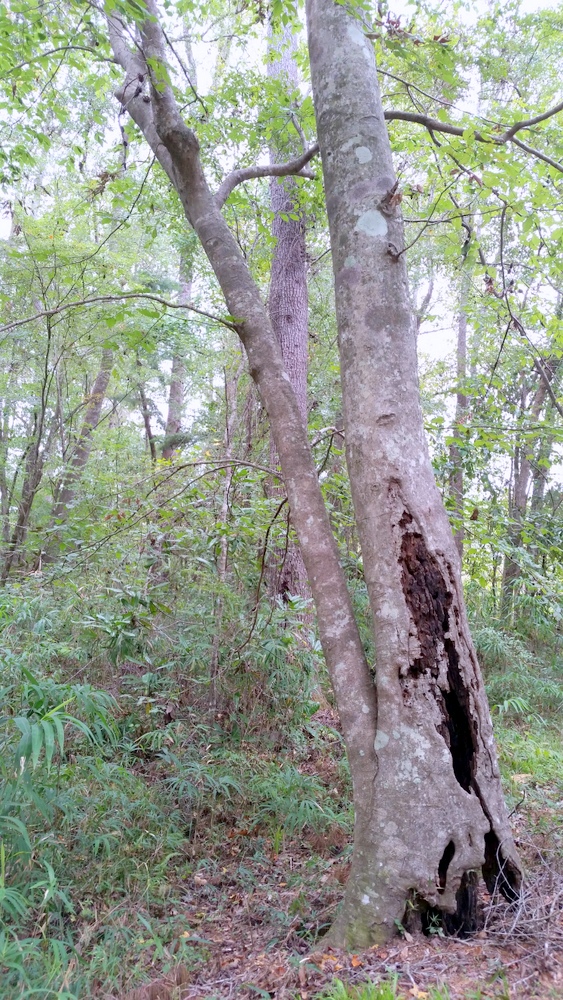
by | Oct 14, 2016
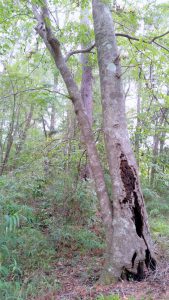
Beech, magnolia and native
river cane (arundinaria) characterize hardwood forests in the Red Hills
Photo by Jed Dillard
I grew up in the Georgia Piedmont outside Athens, a land of bright red sticky clay, rocks and cold weather. In addition to the ubiquitous Georgia pines, hardwoods including white oaks, hickory and beech grow there. I had no clue the Red Hills of Florida and South Georgia would mimic much of that habitat and provide the benefits of fewer rocks to blunt shovels and less cold weather. Now, I can hardly imagine living anywhere else than in one of its beech – magnolia forests.
A friend of mine was doing some work for my neighbor and took the time to look for wild turkey roosting places and walked down to the creek bed through beech, magnolia, spruce pine, white oak and hickory to where the wild azalea grows. “Those sure are some pretty woods, “he told me.
He was describing the upland hardwood forest described by the Florida Natural Areas Inventory as “a well-developed, closed-canopy forest dominated by deciduous hardwood trees on mesic soils in areas sheltered from fire. It typically has a diverse assemblage of deciduous and evergreen tree species in the canopy and midstory, shade-tolerant shrubs, and a sparse groundcover. “ Blaisdell, et al characterized their location as areas “too steep for logging, farming, or grazing and are mesic (wet) enough so that fire rarely occurs in them. “
Many of these areas are relatively small and have escaped intervention. These small areas contribute to patchwork landscapes which provide the key requirements of wildlife habitat- shelter, food and water. Turkeys roost in the spruce pine over the creek and the hens build nests and forage with their poults on the seeds and bugs of the adjacent open fields. I had always thought of Florida as a sandy coastal environment, but these hills have more clay than most Florida sites underneath them. The combination the canopy’s protection of the moisture in layers of organic matter and the soil’s clay maintain a fertile, well-drained soil profile which supports a wide variety of plants and a varied supply of mast.
Of all its flora and fauna, one of its most intriguing species is the Barred Owl, Strix varia. Judy Biss of Calhoun county’s December 4, 2015 Panhandle Outdoors Article, Owls, Florida’s Remarkable Nocturnal Birds of Prey describes the natural history and biology of owls in Florida. The first time I heard a nearby Barred owl, I thought I was in presence of a fierce beast, surely a panther, at least a bob cat. The Tarzan movies filmed at Wakulla Springs used the Barred Owl calls for jungle sounds. Barred owls thrive in this habitat. The open forest floor and mature trees give them room to navigate and an abundant variety of prey. Snags and trees whose limbs are broken off by wind, provide cavities for them and other cavity nesters.
Pretty woods? Upland Hardwood Forests? Climax Beech Magnolia Forests? No matter what you call them, they’re one of the jewels of North Florida’s range of habitats. Get out and enjoy them.
References and additional information.
http://www.sfrc.ufl.edu/extension/4h/ecosystems/upland_hardwoods/upland_hardwoods_description.pdf
“The Role of Magnolia and Beech in Forest Processes in the Tallahassee, Florida, Thomasville, Georgia Area”. Blaisdell, Wooten and Godfrey. Tall Timbers Research Station
http://fnai.org/PDF/NC/Upland_Hardwood_Forest_Final_2010.pdf

by Rick O'Connor | Oct 14, 2016
Most coastal residents along the panhandle are aware of the invasive lionfish and the potential impacts they could have on local fisheries and ecosystems. Since they were first detected in this area in 2010, there have been tournaments, workshops, and presentations, to help locals both learn about the animal and ways to control them. Existing non-profits have joined the fight and new non-profits have formed. In 2015 FWC and local organizations began hosting the Lionfish Removal and Awareness Day (LRAD) events. These are held the weekend after Mother’s Day. During the 2016 event in Pensacola, 8,089 lionfish were removed. In 2016 FWC introduced the Lionfish Challenge. This program began at the conclusion of the LRAD event and ran through September 30. Lionfish, or lionfish tails for those who wanted to keep the animal, could be turned into local collection sights and submitted for state awards and recognition – a Hall of Fame was created and King Lionfish. Over 16,000 lionfish were logged during this event. But has any of this helped? Are we getting control of this invasive species?
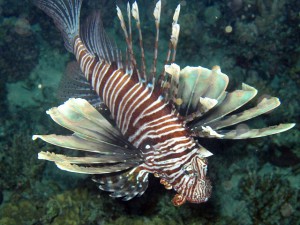
The Invasive Lionfish
Maybe… having conversations with local divers who work with researchers and remove for profit, it appears that the 2016 Pensacola LRAD may have made an impact. If you review the literature it states that to control an invasive species a minimum of 25% of the population should be removed annually. Others say you need to remove 75% and others still say it should be 25% each month. The problem here is that we do not know how many lionfish are actually out there. We know how many we are bringing in but is it enough?
One report, submitted by the non-profit REEF (from Key Largo) a few years ago, indicated they had removed about 70% of the lionfish in their area during one tournament. Based on this, the argument that tournaments are effective was supported. The recent Pensacola LRAD suggest the same. Local divers who remove lionfish with researchers, tourists, and as a commercial venture for themselves told us that their “sweet spots” – where high numbers of lionfish can be found – are not so sweet anymore. They are finding lionfish, but prior to LRAD it was not uncommon for some locations to have 50-100 lionfish around them. These same locations may yield 10-20 now. Though this information is anecdotal; it does suggest that these intensive tournaments may be having an effect on managing them. Of course a quantitative study is needed to confirm these observations, but it is encouraging none the less.
It is believed the tournaments alone will not solve the problem. With their high reproductive rates, continuous removals are needed. To encourage this divers can obtain a Saltwater Products License from FWC and sell what they catch. Some dive charters are now making it a tourism trip – “lionfish hunting”. As long as it marketed properly (as in they are not going to find tons of them – but will enjoy shooting a few) customers seem to be happy and are enjoying it. Of course they are still working on an effective trap so that non-divers can participate in control programs. It is also important to note that you should not get into a commercial venture on lionfish as your main source of income. To do so would lead to the argument “we do not want to get rid of lionfish because they are my livelihood”. The objective is to make them uncommon and reduce their impact on our marine resources.
Of course it will take time to know for sure just how effective the tournaments have been. Several will be meeting this week in Ocala to discuss the 2017 tournament season. I have written a longer update on the lionfish, which can be found at the Escambia County Extension Marine Science page.
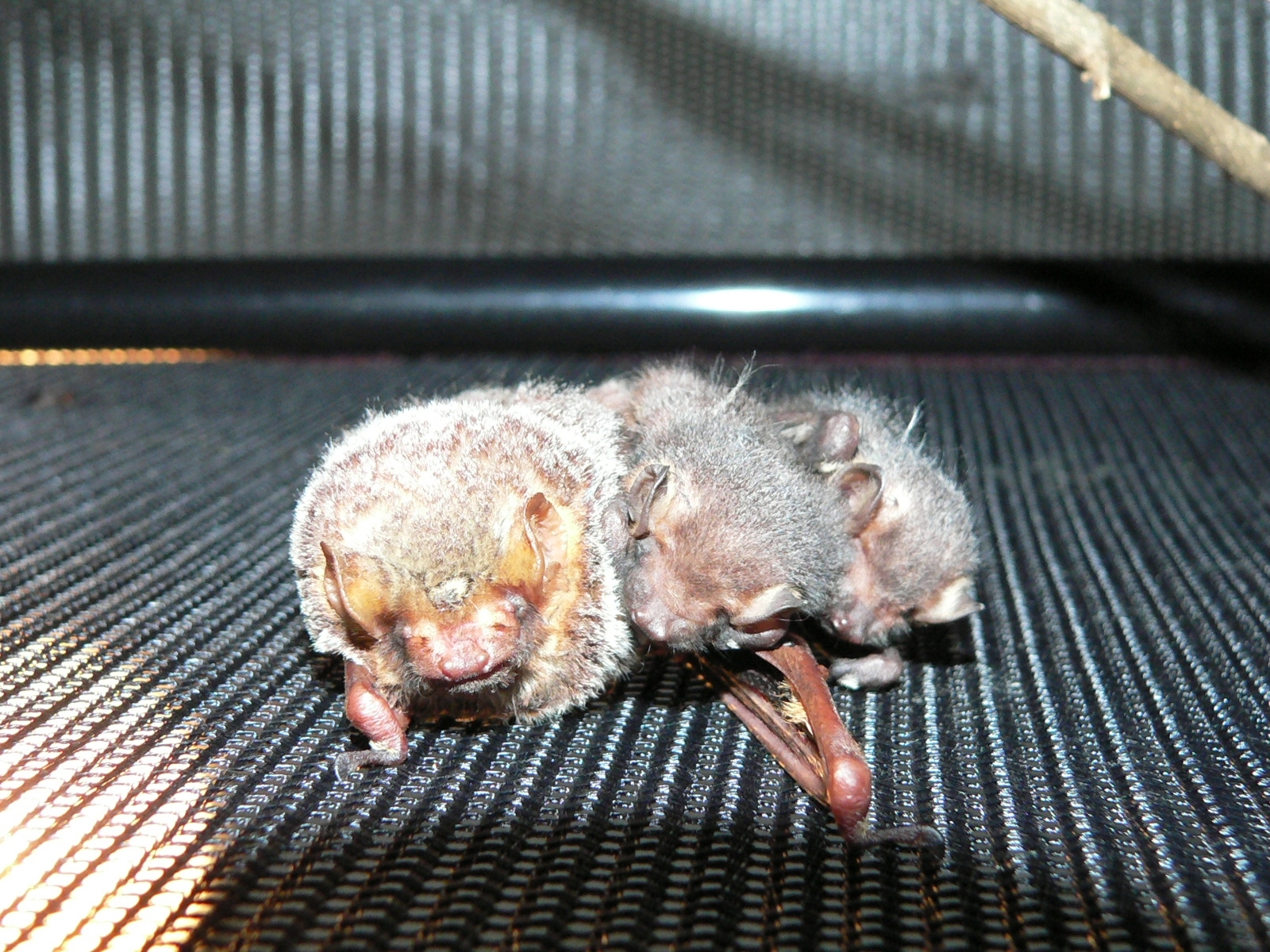
by Carrie Stevenson | Oct 7, 2016
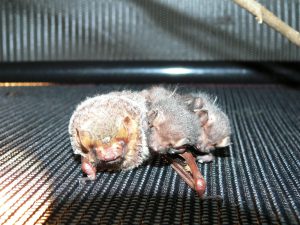
This close-up photo of a Seminole bat and her two pups exhibits their furry, mammalian traits. Photo credit: Carrie Stevenson, UF IFAS Extension
As we enter Halloween season, one of the most popular images of this spooky time of year is that of a bat. The creepy tales of vampire bats and Dracula are enduring and certainly exciting. Unfortunately, many negative connotations exist around this fascinating species. Perhaps you’ve heard they carry rabies, that they will fly into your hair, or that many of them are considered blood-sucking vampire bats?
In fact, there are many benefits to having bats in one’s landscape, neighborhood, or farm. The predominant role of bats in our local ecosystems is that of insect predator. A single little brown bat (Myotis lucifugis), which is native to the Florida Panhandle, can eat 1,200 insects (including mosquitoes) in one hour of feeding! In Texas, a recent study put the economic value of bats due to their consumption of agricultural pests on cotton farms at $74/acre. Extrapolated values of bats’ pest suppression services to US agriculture is in the billions of dollars annually.
Other species in warmer climates eat fruit and play a major role in reforesting rain forests in Central and South America—after digesting the fruit they leave seeds in their droppings (guano is excellent fertilizer, by the way), helping replant 95% of the very trees they feed upon. Some species feed on nectar, filling the same role as bees and helping pollinate bananas, avocados, cashews, and figs.
Contrary to popular belief, bats are not blind and many have excellent vision. However, they do rely heavily on echolocation to sense prey and are extremely accurate hunters. Viewed close up, many people consider the small, furry animals rather cute, as opposed to frightening. They often fly erratically because they are chasing very small flying insects, so the only reason one would end up in a person’s hair is if a mosquito flew through it with a bat in chase! While vampire bats do exist, there are only 3 out of over 1,000 species of bats that feed on blood, and they all live in Latin America. They also tend to feed on the blood of livestock.
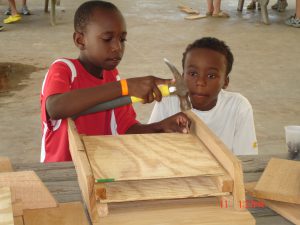
Building a bat house is a great activity for kids interested in wildlife. Photo credit: Carrie Stevenson, UF IFAS Extension
Human contact with bats is rare unless the bats are sick, which is why one found on the ground should be left alone. Rabies transmission from bats accounts for only one death per year in the United States—a statistic much less than that of deaths from dog bites, bee stings, and lighting strikes! In fact, several towns in Texas with the highest populations of bats in the country have recorded zero human bat-transmitted rabies cases.
Bat populations are declining in North America due to disease (particularly white-nose syndrome), loss of habitat, and the slow reproductive cycle of bats. However, you can help the world’s only flying mammal by installing a bat house in your yard. Keep in mind that bats attracted to bat houses prefer to be in open areas away from trees (where their predators hide), and the house should be installed at least 12 feet in the air. Bat houses can be purchased or built rather simply—this UF IFAS Extension publication outlines several types, or visit Bat Conservation International’s website for simple instructions.












